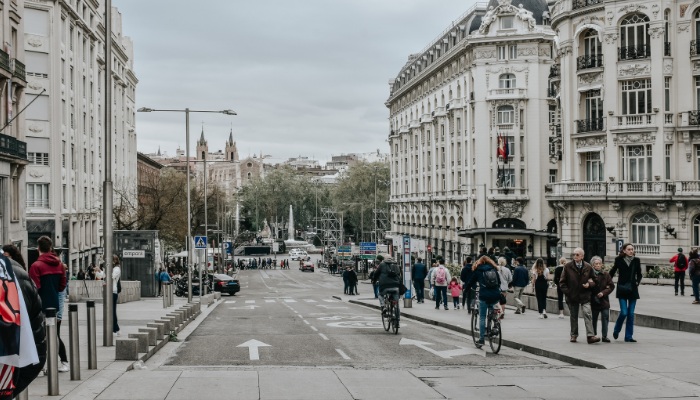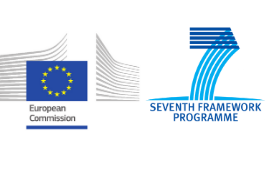- Innovative Policy Modelling and Governance Tools for Sustainable Post-Crisis Urban Development
- Consortium: Universidad Politécnica de Madrid (project coordinator), Nommon, Centre for Advanced Spatial Analysis (CASA) at University College London, Urban Planning Group at Eindhoven University of Technology, Instituto de Física Interdisciplinar y Sistemas Complejos at the University of the Balearic Islands, Institut Municipal d’Informàtica at Ajuntament de Barcelona.
- 2013 – 2016

The project
INSIGHT (Innovative Policy Modelling and Governance Tools for Sustainable Post-Crisis Urban Development) is a research project funded under the ICT Theme of the European Union’s Seventh Framework Programme. INSIGHT aimed to investigate how ICT can help European cities formulate and evaluate policies to stimulate a balanced economic recovery and a sustainable urban development. The project was conducted by a consortium composed of the Technical University of Madrid (project coordinator), Nommon, the Centre for Advanced Spatial Analysis (CASA), the Technical University of Eindhoven, the Institute for Cross-Disciplinary Physics and Complex Systems (IFISC), and the Barcelona City Council. The project started in October 2013 and ran for 36 months.
Context
Cities embody the twofold challenge facing the European Union: how to improve competitiveness while achieving social cohesion and environmental sustainability. They are fertile ground for science and technology, innovation and cultural activity, but also places where problems such as environmental pollution, unemployment, segregation and poverty are concentrated. The project INSIGHT aimed to investigate how ICT with particular focus on data science and complexity theory can help cities create and evaluate policies to promote a balanced recovery and a sustainable urban development.
INSIGHT’s objectives
The objectives of the project were the following:
- To investigate how data from multiple distributed sources available in the context of the open data, the big data and the smart city movements, can be managed, analysed and visualised to understand urban development patterns.
- To apply these data mining functionalities to characterise the drivers of the spatial distribution of activities in European cities, focusing on the retail, housing, and public services sectors, and paying special attention to the impact of the current economic crisis.
- To develop enhanced spatial interaction and location models for retail, housing, and public services.
- To integrate the new theoretical models into state-of-the-art simulation tools, in order to develop enhanced decision support systems able to provide scientific evidence in support of policy options for post-crisis urban development.
- To develop innovative visualisation tools to enable stakeholder interaction with the new urban simulation and decision support tools and facilitate the analysis and interpretation of the simulation outcomes.
- To develop methodological procedures for the use of the tools in policy design processes, and evaluate and demonstrate the capabilities of the tools through four case studies carried out in cooperation with the cities of Barcelona, Madrid, London, and Rotterdam.
Read INSIGHT Position Paper to know more about the project.
Public deliverables
- D2.1 Stakeholder Consultation Report
- D2.2 Integrated Approach to Urban Planning and Governance
- D2.3 Review of Urban Models and their Use in Urban Policy
- D2.4 Models and Tools Evaluation Framework
- D3.2 Analysis of Urban Location Patterns
- D4.1 Housing-Retail-Public Services Interaction Models
- D4.2 Housing Location Models
- D4.3 Retail Location Models
- D4.4 Public Services Location Models
- D5.1 Enhanced Version of the Albatross Simulation Model
- D5.2 Enhanced Version of the SIMULACRA Simulation Model
- D5.3 Enhanced Version of the MARS Simulation Model
- D5.4 Enhanced Version of the MATSim Simulation Model
- D6.1 Visual Ecosystem Technical Specification and Design
- D6.2 Visualisation Tools for Simulation and Scenario Analysis
- D6.3 Visualisation Tools for Evidence-based Decision Support
- D7.1 Madrid Case Study Report
- D7.2 London Case Study Report
- D7.3 Rotterdam Case Study Report
- D7.4 Barcelona Case Study Report
- D7.5 Models and Tools Comparative Evaluation and Impact Assessment
- D8.1 First Dissemination Package
- D8.2 Second Dissemination Package
- D8.3 Third Dissemination Package
Journal articles
- Bassolas, A., M. Lenormand, A. Tugores, B. Gonçalves and Ramasco, J.J. (2016) Touristic site attractiveness seen through Twitter. EPJ Data Sci. (2016) 5: 12.
- Batty, M. and A. Hudson-Smith (2014) Visual Analytics for Urban Design. Urban Design, Issue 132, 38-41.
- Batty M., C. Vargas, D. Smith, J. Serras, J. Reades and A. Johansson (2013) SIMULACRA: Fast Land-Use—Transportation Models for the Rapid Assessment of Urban Futures. Environment and Planning B: Planning and Design December 2013 40:987-1002.
- Dane, G., A. Grigolon, S. Rasouli and H.J.P. Timmermans (2014) Impact of Economic Crisis on the Intention to Move House. Procedia Environmental Sciences, 22, 2014, p. 380-386.
- García-Palomares, J. C., J. Gutiérrez and C. Mínguez (2015) Identification of tourist hot spots based on social networks: a comparative analysis of European metropolises using photo-sharing services and GIS. Applied Geography, 63, 408-417.
- Grigolon, A., G. Dane, S. Rasouli and H.J.P. Timmermans (2014) Binomial Random Parameters Logistic Regression Model of Housing Satisfaction. Procedia Environmental Sciences, 22, 2014, p. 280-287.
- Gutiérrez, J., M.H. Salas-Olmedo, B. Gómez-Moya and J.C. García-Palomares (2016) Dynamic accessibility using big data: the role of the changing conditions of network congestion and destination attractiveness. Networks and Spatial Economics: 1566-113X, 1572-9427.
- Gutiérrez, J., J.C. García-Palomares and M.H. Salas-Olmedo (2016) Big (Geo)Data en Ciencias Sociales: Retos y oportunidades. Revista de Estudios Andaluces 33 (2016), 1-23.
- Gutiérrez, J., García-Palomares, J.C., Romanillos, G., Salas-Olmedo, M.H. (2016) Airbnb in Tourist Cities: Comparing Spatial Patterns of Hotels and Peer-to-Peer Accommodation. Accepted for publication in Tourism Management: 0261-5177.
- Lenormand, M., Picornell, M., Cantú-Ros, O.G., Tugores, A., Louail, T., Herranz, R., Barthélemy, M., Frías-Martínez, E., and Ramasco, J.J. (2014) Cross-Checking Different Sources of Mobility Information. PLoS ONE 9(8): e105184.
- Lenormand, M., A. Tugores, P. Colet and J.J. Ramasco (2014) Tweets on the Road. PLoS ONE 9(8): e105407.
- Lenormand, M., T. Louail, O.G. Cantú-Ros, M. Picornell, R. Herranz, J. Murillo Arias, M. Barthelemy, M., San Miguel, J.J. Ramasco (2015) Influence of sociodemographic characteristics on human mobility. Scientific Reports 5, 10075.
- Lenormand, M., B. Gonçalves, A. Tugores and J.J. Ramasco (2015) Human diffusion and city influence. Journal of the Royal Society Interface 12, 20150473.
- Lenormand, M., M. Picornell, O.G. Cantú-Ros, T. Louail, R. Herranz, M. Barthélemy, E. Frías-Martínez, M., San Miguel and J.J. Ramasco (2015) Comparing and modelling land use organization in cities. R. Soc. open sci. 2015 2 150449.
- Lenormand, M., A. Bassolas, and J.J. Ramasco (2016) Systematic comparison of trip distribution laws and models. Journal of Transport Geography 51, 158-169.
- Masucci A.P., K. Stanilov and M. Batty (2014) Exploring the Evolution of London’s Street Network in the Information Space: a Dual Approach. Physical Review E 89, 012805.
- Murcio, R., R. Morphet, M. Batty and C. Gershenson (2015) Urban Transfer Entropy across Scales. PLoS ONE 10(7): e0133780.
- O’Brien, O., J. Cheshire and M. Batty (2015) Mining Bicycle Sharing Data for Generating Insights in Sustainable Transport Systems. Journal of Transport Geography, 34, 262–273.
- Picornell, M., T. Ruiz, M. Lenormand, J.J. Ramasco, T. Dubernet and E. Frías-Martínez (2015) Exploring the potential of phone call data to characterize the relationship between social network and travel behavior. Transportation, 1-22.
- Piovano, L., D. Garrido, R. Silva and I. Galloso (2014) What (Smart) Data Visualizations Can Offer to Smart City Science. Communications & Strategies 96.
- Romanillos, G. and García-Palomares, J.C. (2016) Evaluating accessibility to Public Services: The role of location strategies and the impact of urban density. Urban Studies: 0042-0980; 1360-063X.
- Wang, Y. (2016) Transport Policy evaluation by LUTI model (MARS). Land Use-Transport Interaction Models 1, 34-58.
- Zhong C., Batty, M., Manley, E., Wang, J., Wang, Z., Chen, F., et al. (2016) Variability in Regularity: Mining Temporal Mobility Patterns in London, Singapore and Beijing Using Smart-Card Data. PLoS ONE 11(2): e0149222.
- Zhong C., E. Manley, S.M. Arisona, M. Batty and G. Schmitt (2015) Measuring variability of mobility patterns from multiday smart-card data, Journal of Computational Science, 9, 125-130.

INSIGHT was funded under the ICT theme of the European Union’s Seventh Framework Programme (FP7/2007-2013), under grant agreement no. 611307.